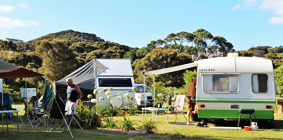 Holiday Park visitors spend $733m a year | Scoop News:
Holiday Park visitors spend $733m a year | Scoop News:
Holiday Parks Association Holiday Park visitors spend $733m a year While staying at Holiday Parks, visitors’ contribution in terms of direct expenditure to New Zealand’s economy in areas such as cafes, activities, rental vehicles and accommodation, may be as high as $733 million each year, new research shows.
Approximately $372 million (51%) of this expenditure is attributable to domestic visitors and the remaining $362 million (49%) to international visitors, according to the research carried out by Angus & Associates* for the Holiday Parks Association (HAPNZ).
New Zealand Holiday Parks generate 6.2 million guest nights a year, from 3 million guest arrivals. This level of activity represented 20% of all commercial guest nights in New Zealand last year. While the majority of Holiday Park guest nights are used by domestic visitors (68%), the international market has doubled since the late 1990s (from approximately 15%, to 32% of the total in 2012).[2] Angus & Associates found that visitors spent an average of $113.66 per night ($87.85 for domestic visitors and $180.24 for international visitors) while staying in Holiday Parks.
The study was undertaken in the 2012-13 peak season (late December and early January), and considered expenditure across a range of regions and by a variety of visitor types (for example, those staying in built and non-built accommodation). By extrapolating the peak season average daily expenditure over the 2012 year, the researchers concluded that visitors may have spent as much as $733 million while staying at Holiday Parks, HAPNZ Chief Executive Fergus Brown says.
“While expenditure may be lower over the shoulder seasons, as visitors may be less inclined to participate (and pay for) outdoor activities, for example, they may also spend more on accommodation when the weather is less favourable,” Mr Brown says.
The research revealed that an average of just 26% of daily expenditure by Holiday Park visitors goes toward Holiday Park accommodation costs.
“The balance, which totals approximately $541 million annually, is typically spent outside Holiday Parks in areas such as hospitality (cafes, restaurants, bars), activities and attractions, transport (rental vehicles, fuel, buses, taxis), retail goods and services, and entertainment,” Mr Brown says.
Holiday Park Visitors
Year Ending December 2012:
Accommodation 26% $193 million
Groceries/Snacks 15% $112 million
Transport 12% $88 million
Activities/Admission Fees 12% $86 million
Cafes/Restaurants/Eating out 11% $79 million
Petrol/Fuel 9% $66 million
Bars/Nightclubs/Alcohol 2% $15 million
Other Shopping 13% $95 million
TOTAL 100% $733 millionWhile international visitors tended to spend significantly more on activities and attractions and transport, domestic visitors spent slightly more on accommodation and goods such as snacks and groceries.
Holiday Park visitors spend on a very wide range of items, meaning that the economic benefit for the host community is well spread and not limited to small ticket items. For example, the research identified expenditure on (amongst a wide range of other goods and services) pharmacy items, furniture, clothes, art, a new vehicle, jewellery, books, and movie tickets.
International visitors had a much shorter average length of stay at a Holiday Park (since they tended to be ‘touring’), while domestic visitors were more often ‘staying put’. So, while international visitors spent more on a daily basis, domestic visitors spent more on a ‘per stay’ (or ‘per arrival’) basis.
“Holiday Parks as a business entity also make a significant economic contribution to their region/community through employing staff (the sector employs approximately 2000 people, purchasing supplies, upgrading and maintenance of facilities, and payments for marketing and professional fees,” Mr Brown says.
The stimulation of other (indirect) expenditure should also be taken into account. For example, the dairy that employs an extra person over summer to cope with the business generated by Holiday Parks; the boat store that places additional radio advertising to attract purchases from Holiday Park visitors; and the local council that reseals the public road leading to the Holiday Park.
“So the true ‘value’ of the sector, and the economic contribution made by Holiday Parks, could well be much greater than the estimated direct visitor expenditure of $733 million a year,” Mr Brown says.
Finally, it is worth noting that, compared with other New Zealand industries, the direct economic contribution attributable to Holiday Park visitors is greater than the TV production industry (approximately $575 million annually and the horse racing industry ($424 million, and very similar in size to the distilled spirits industry ($800 million. The export earnings attributable to the Holiday Park sector are as substantial as those generated by New Zealand’s apple industry ($363 million in 2011).
* Angus & Associates is a premier supplier of marketing, research and strategic planning services. They are focused on delivering informed insights for a range of private and public sector clients, particularly within the tourism and leisure sectors.

